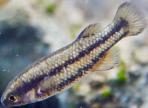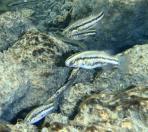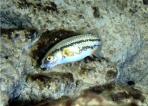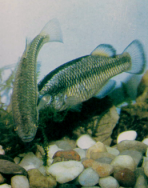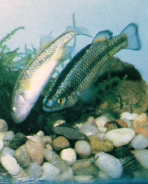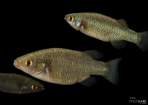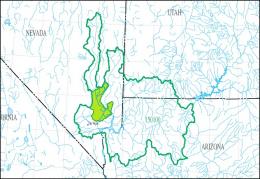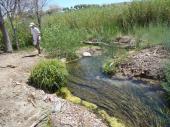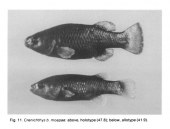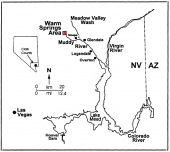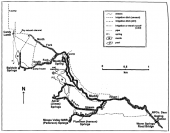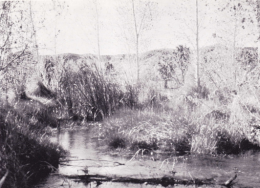- HOME
- WHO WE ARE
- NEWS AND DATES
- GOODEIDS
- PHYLOGENY
- ARTIFICIAL KEY
- GOODEID SPECIES
- BIOLOGY
- ENVIRONMENT
- CONSERVATION
- PROFUNDULIDS
- MEMBERS AREA
Crenichthys cf. baileyi
English Name:
Muddy River Springfish
Original Description:
undescribed species (for further information go to the chapter "Remarks")
Holotype:
undescribed species (for further information go to the chapter "Remarks")
Terra typica:
undescribed species (for further information go to the chapter "Remarks")
Etymology:
undescribed species (for further information go to the chapter "Remarks")
The genus was erected by Hubbs in 1932 with the generic name refering to the typical habitat of this genus, namely springs. It is derived from the ancient Greek with κρήνη (kréne or créne) meaning spring and ἰχθύς (íchthús, íchthýs), the Greek word for fish. The name of the genus simply means "Springfish".
Synonyms:
Cyprinodon macularius baileyi Gilbert, 1893
Cyprinodon baileyi Jordan & Evermann, 1896
Crenichthys baileyi Sumner & Sargent, 1940
Crenichthys baileyi moapae Wiliams & Wilde, 1981
Distribution and ESU's:
This species occurs exclusively in and around five warm water springs in the headwaters of the Muddy River, Clark County, Nevada. Populations of closely related fish in the White River drainage belong to Crenichthys baileyi.
ESU ist short for Evolutionarily Significant Unit. Each unit expresses an isolated population with different genetic characteristics within one species. ESU's can be defined by Molecular genetics, Morphology and/or Zoogeography and help in indicating different phylogenetic lineages within a species. The abbreviation for an ESU is composed of three letters of the genus, followed by the first two letters of the species name and an ongoing number in each species.
In the subfamily Empetrichyinae, no ESU's were in use so far. To align with the livebearing subfamily Goodeinae, the GWG wants to bring a system in use based on John Lyons' naming for this subfamily. In Crenichthys nevadae, we actually (until the new species is described) distinguish five ESU's based on genetics and biogeography. Creba1 encompasses the type population from Ash Spring (corresponding with C. b. baileyi), Creba2 the neighbouring one from Crystal and Hiko Springs (C. b. grandis). We suggest Creba3 for the fish from Preston (C. b. albivallis) and Creba4 for the fish from Moon, Moorman and Hot Springs (C. b. thermophilus). Those last two ESU's are genetically almost identical, nevertheless we place them in two separate ESU's for not violating the existing system with subspecies too much, but also for taking account of the geographic separation. For more details about all of these fish, go to Crenichthys baileyi. The fifth and last ESU, Creba5, we want to bring in use for the Muddy River populations (C. b. moapae), that represent a subspecies that probably deserves full species rank. We exclusively focus on this ESU here.
The left map shows the Lower Colorado-Lake Mead Accounting Unit (HUC 150100) of the Lower Colorado Basin Region (HUC 15), the right map the Muddy River Cataloging Unit (HUC 15010012):
Status :
International Union for Conservation of Nature (IUCN): not assessed (undescribed species)
U.S. Fish & Wildlife Service (ECOS): not listed
Habitat:
The Muddy River Springfish inhabits vegetated warm springs and their outflows and marshes in the headwaters of the Muddy (Moapa) River known as the Warm Springs Natural Area. The following lines are a habitat description by John A. Kopec from 1949: "The many warm springs of the Moapa Valley make up the headwaters of the Moapa, or Muddy River. Some of these springs have a rather slow currrent with large pools measuring up to 2.1m in depth and 7.6m in diameter. Others form streams that run swiftly and cool rapidly. The water maintain a nearly uniform temperature at the spring sources. In December, 1941, the readings were 32°C at each spring tested. The pH ranged from 7.4 to 7.5. The bottoms of the streams are generally muddy with some rocks protruding. A grass-like plant, Eleocharis acicularis, abounds in the faster currents. Some of these plants live entirely out of the water, others are partly submerged and still others are wholly submerged with at least 90cm of water over them."
Paul Loiselle visited a habitat of this species in the 1970's next to Pedersen's Warm Spring. Typical for the area where the Muddy River Springfish occurs are warm springs breaking out of the ground, followed by small and short rivers or creeks. Here is his description of the habitat he visited, slightly modified: "Crenichthys cf. baileyi frequently occurred in such a river, which ran about 300m and then flowed into a farmer's irrigation system. The greatest depth was 45cm and the water ran fairly quickly. The creek bed was very uneven, covered with individual boulders up to 30cm in diameter. The water temperature was 29°C warm, very hard and had a pH of 8.0. The zones of slow current were covered with Vallisneria, while in the sections with rapid flow, I found only a few batches of Pondweed with beautiful dark red leaves. All the stones in the stream bed were covered with algae. The Springfish was by far the most common fish in this habitat. Small groups up to two dozen individuals swam around, and could be often seen searching the ground. The fish stayed very close to the bottom and dashed away at great speed when disturbed. After such outbursts, the most fearful ones ended up hiding among stones. Then the stripe pattern on the back proved being a good camouflage against view from above. Most of the fish swimming in open water were fully grown specimens. Young ones swam in and out of the nearbyVallisneria vegetation, while the smallest fish of less than 12mm in length were to be found in the Vallisneria leaves on the surface. Neither the younger nor the adult fish had the slightest difficulty in getting to assert against the rather strong current."
Biology:
John Kopec (1949) observed many schools of Crenichthys cf. baileyi in "one large pool where most of the collecting was done. The schools consisted of not more than 25 indiividuals; however, in the smaller and swifter streams the schools comprised as many as 250 fish. This greater abundance in the swifter water may be due to a more ample food supply. In the larger pools the fish were observed spawning and one egg was noted on the aquatic fibrous roots of a smoke tree, Parosela spinosa (now: Psorothamnus spinosus)." When trying to breed this fish under aquarium conditions, "only one egg is layed and fertiIized at a time. The act is repeated until from 10 to 17 eggs are deposited at each spawning. The eggs measure 1.9mm in diameter. By isolating freshly layed eggs singly in floating vials in the aquarium, the incubation period wa found to vary from 5 to 7 days." Loiselle reported that a 5.2cm long female layed a maximum of 21 eggs, daily around 10 with about 2mm diameter. At 25°C they hatched within 10 days. Muddy River Springfish spawn year-round with peak spawning activity from April through August (Scoppettone et al., 1987).
Diet:
Size:
The maximum known SL is 60mm
Colouration:
Young specimens of this species appear white, whitish or creme with a prominent dark lateral stripe and a less prominent abdominal one. The back in growing up individuals gets darker, slightly brown to greenish with the base of anal and dorsal fin in orange or yellow, the belly creme to whitish. Courting males display a broad medial strip from dorsal fin to the tip of the snout, the area between medial and lateral line gets strikingly silver to brightly blue. Males display broad dark terminal bands in unpaired fins. Old individuals lose the stripes and get plain silvery green with the belly paler, brownish or a bit orange sometimes. The bases of anal and dorsal fin stay yellow to orange.
Sexual Dimorphism:
The sexes differ mainly in shape, fins and colouration. Males are higher in body and appear stronger, anal and dorsal fins are longer and have a more sailfin shape while the these fins of females are shorter and the fins are rather shaped like a rhombus. Male unpair fins express a broad dark to black terminal band and are coloured more intensively while those of females stay mainly clear or are slightly coloured. Males have their lateral band broader than females but less distinct and the medial stripe in males is darker and more prominant, especially during courtship.
Remarks:
The Muddy River Springfish of Moapa White River Springfish was described by Jack E. Williams and Gene R. Wilde in a paper about the taxonomy and morphology of isolated populations of the White River Springfish, published in 1981, as a subspecies of Crenichthys baileyi, Crenichthys baileyi moapae. However, until this subspecies gets full species rank, we call it here Crenichthys cf. baileyi. The original description of the subspecies was made in:
WILLIAMS, J. E. & G. R. WILDE (1981): Taxonomic status and morphology of isolated populations of the white river springfish, Crenichthys baileyi (Cyprinodontidae), Southwestern Naturalist v.25, Nr. 4: pp 485 - 503
The Collection number of the Holotype of this subspecies sensu Williams & Wilde is: Unversity of Michigan Museum and Zoology, Cat. No. UMMZ-203338. It is an adult male of 47.8mm standard length, collected together with a female Allotype (Cat. No. UMMZ-203339) of 41.9mm SL and 61 Paratopotypes (Cat. No. ASU-5231), 16.8 to 56.8mm long. They were sampled in Cardy Lamb Spring, Clark County, Nevada, by M. Belcher on February 26th, 1967. The subspecies epithet can be derived fom the language of the Paiute people with moa meaning muddy and pah meaning water, so muddy water. Moapa was the original name of the Muddy River, so it clearly refers to the river basin where the subspecies is restricted to, the Moapa or Muddy River.
The left picture shows the types of Crenichthys baileyi moapae from Williams and Wilde, the other two male (middle) and female (right) from Pedersen's Warm Spring, photo by Paul Loiselle in the 1970's:
The left picture in the upper row shows the distribution of Crenichthys baileyi along the White River, marked the different suspecies sensu Williams and Wilde. The green ellipse circles the habitats of C. b. albivallis, the pink one those of C. b. thermophilus. In violet are marked the two springs where C. b. grandis is known from and the red circle marks the type locality of this species respectively from C. b. baileyi. With a blue circle are marked the habitats of C. cf. baileyi, described by Williams and Wilde as C. b. moapae. The middle picture shows the Warm Springs Natural Area on a Muddy River map (marked in red) and the right one the spring area in detail. Springfish appear in the rivers and creeks and five spring areas (Cardy Lamb, Baldwin, Muddy, Pedersen and Apcar Springs). The lower row shows two pictures from the outflow of Pedersen's Warm Spring, Photo by Paul Loiselle in the 1970's:
The Muddy River Springfish is the most abundant native fish in the upper Muddy River and the Warm Springs Natural Area. This area was formerly a ranch of nearly 500 ha purchased by the famous Howard Robard Hughes Jr. in 1968. A huge part of it was acquired by the LDS-Church in 1978, but most of it was sold again pretty soon. With the intention to protect the headwaters of the Muddy River and the habitat of the endangered Moapa dace (Moapa coriacea), almost the whole former ranch area is since 2007 in possession of the Southern Nevada Water Authority and is now a nature conservancy and publicly accessible nature area (Moapa Valley National Wildlife Refuge). Over the past 12 years, intensive restoration work has been done with the Apcar stream that had finally very positive effect not only on the extremly rare Moapa dace, but also on Springfish. During a biannual count done by biologists from he Southern Nevada Water Authority (SNWA), US Fish and Wildlife Service (USFW) and the Nevada Department of Wildlife (NDOW) from February 23rd and 24th, 2021, also Springfish were counted and David Syzdek (SNWA) found this species to be "fairly abundant and only in the thermal waters in the Warm Springs area.”
An apparently introduced population may still exist in a spring about 2km from Glendale along the Moapa River (Williams and Wilde, 1981), but this needs to be verified.
In 2017, D. Cooper Campbell and Kyle R. Piller published a phylogenetic study of the Empetrichthyinae. Concerning Crenichthys baileyi, individuals from ten localities were included, namely the three springs where C. b. thermophilus occurs (Moon River Hot Spring, Moorman Hot Spring, Hot Creek), Crystal North and South Springs as well as Hiko Spring (representing C. b. grandis), Ash Sping (C.b.baileyi), Preston Big Spring (C. b. albivallis) and fish from the Muddy River and Hidden Valley Pond representing C. b. moapae. The studies were separatly done on the mitochondrial gene Cytochrome b and three nucleotide sequences, namely S7 intron-1, S8 intron-4, and P0 intron-1. Concerning cytb, the authors found only four clades. Three monophyletic clades representing the three subspecies C. b. baileyi, grandis and moapae (with moapae being a sister clade to a pair formed by grandis and baileyi) and a fourth clade composed of C. b. albivallis and thermophilus. Concerning the three introns, C. b. moapae was recovered as sister to all other C. baileyi populations. None of the subspecies within C. baileyi were separated by the TCS criterion into separate Haplotype networks. Phylogeny from species tree analysis based on cytb hypothesis following Bayesian statistics supports a model of two species. Taking in consideration genetic distances in the cytb gene of 1.3 to 1.7% that separate species in the Goodeinae and the result of the tree analyis, we follow a conservative approach here and recognize two species: Crenichthys baileyi from the type locality and the described subspecies C. b. albivallis, grandis and thermophilus, and Crenichthys cf. bailyei from the southern habitats in the Muddy River headwaters, C. b. moapae sensu Williams and Wilde.
Species of the subfamily Empetrichthyinae are oviparous fishes and share the lack of pelvic fins, while the subfamily Goodeinae is livebearing. Lynne Parenti (1981) finally proposed this subfamily as sister group to the Goodeinae and encompassed both in the family Goodeidae. Meanwhile the monophyly of the family Goodeidae and the narrow relationship between both subfamilies has been supported through several studies since the 1980's and is not doubted any longer.
Husbandry:
Looking on the biotopes of Crenichthys cf. baileyi, they suggest the species may prefer a habitat with moderate to swift current, structured with gravel, rocks, roots, branches, fallen leaves and river bank vegetation. Fry is rarely eaten, but it may depend on the quantity and quality of food and on the number of places to hide. When several different stages of juveniles occur, fry will be neglected, so it makes eventually sense to add separate brought up fry to the group with a size of 1.5 or 2cm to provide these stages and get a flock breeding colony.
The recommended tank size is at least 100 liters, bigger tanks with a generous base and little height (25cm are enough) are better for sure. With rocks and vegetation in the corners and backside of the tank well structured tanks combined with some roots and/or wood seem to do best with this species. The current should be moderate or swift, but the species can deal wih low oxygen values (down to 3mg/l).
In the wild, the species feeds mainly from small or middle-sized invertebrates like bloodworms or insect larvae, gammarids, ostracods, but also algae, aufwuchs, detritus and other organic matters, so feeding with similar food, water fleas, Mysids and other food from animalistic sources as well as stones and pebbles covered with green algae will be best for this omnivorous fish. In aquarium, it feeds very well from flake food, granulate and tablets, additionally given Nauplia of Brine Shrimps are eaten greedy. Additionally, as aufwuchs and green algae are taken in the natural habitat, providing some kind of vegetables like boiled peas is a good food supplement. The species is not shy.
Concerning water quality, this species is in need of bigger water changes (60-80% every week) like most of the Goodeids, especially river and spring inhabiting species, so an automatic water changing system can be helpful, but in contrast to most of the Goodeid species from Mexico, it needs to be temperated and the oxygen level could be low. This species does best at temperatures between 25 and 29°C though it is able to withstand lower temperatures down to even 12°C for a short period.
This species is doing very well when is kept in the open from spring to fall, starting when the water temperature by night does no more deceed 18°C and colder periods are no longer expected. Bring them out in the early afternoon, the time of the day with the highest water temperature. Bring the fish in before the water temperature deceeds 18°C by night and keep them at this temperature for the first days, then slowly raise the temperature to the convenient range of this species over the winter time.
Populations in holding:
Here each species are assigned populations of fish in husbandry and in brackets aliases of these locations to assist in identifying own stocks. Each population is assigned a unique Population-ID, composed by the ESU, the subbasin where this population is occurring (three capital letters) and a unique location identifier.
Populations in holding:
1. Creba5-MUR-MuRiv
Population: Muddy Spring (aka Moapa River, Crenichthys baileyi moapae)
Region: Lower Colorado Basin
Accounting Unit: Lower Colorado-Lake Mead
Cataloging Unit: Muddy River
Locality: Warm Springs Natural Area in the Muddy River headwaters



